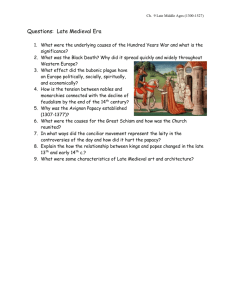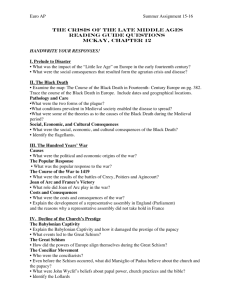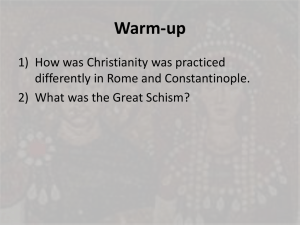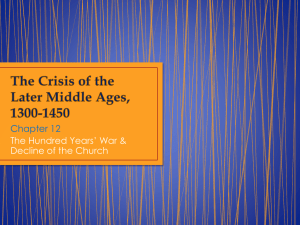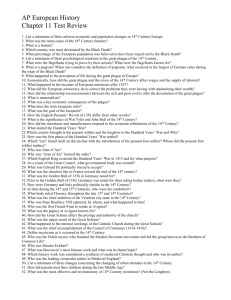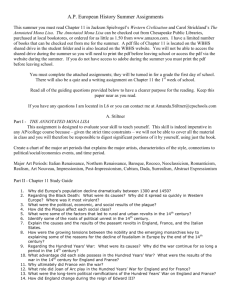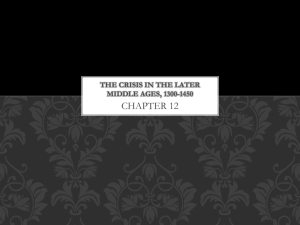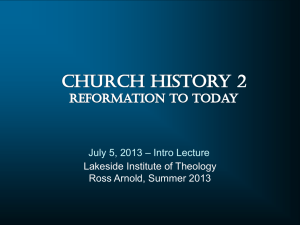View Presentation
advertisement
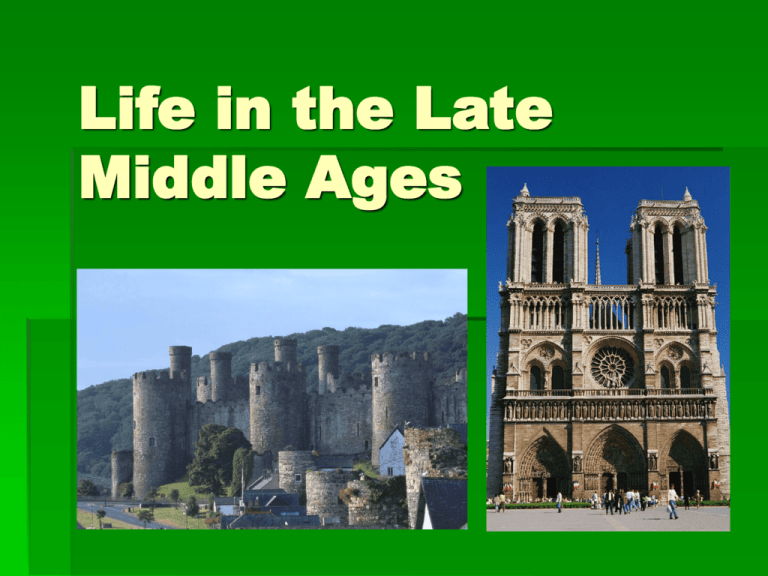
Life in the Late Middle Ages Height of Medieval Civilization By the beginning of the 14th century, European society had reached stability and prosperity. The economy (while still largely based on farming- manorialism) was growing, population ballooned, weather and harvests were good, political (feudalism) and religious life (Catholicism) were stable. This drastically changed in the middle 14th century. The Black Death Black Death (1347): loss of 1/3 of European population (mostly in cities) Causes: bubonic plague carried by fleas on Asian black rats; poor sanitation, overcrowded homes, poor health, poor hygiene, poor housing, change in climate conditions (little ice age) The Black Death Results: Severe impact on European economy; in some areas workers enjoyed higher wages; Best of clergy died (staying behind to help the sick); Jews blamed; serfdom ended in many areas; first enclosure of fields in Britain Population did not reach pre-plague level until the mid-16th century. Crisis in the Catholic Church Early Criticisms of the church Marsiglio de Padua: Defender of Peace – Church should be subordinate to the state Church should be governed by a council of laity and priests superior to pope. John Wyclif (1320-1384): church should only follow Scripture; English translation of Bible; his later followers were Lollards John Huss (1369-1415): ideas similar to Wyclif; nationalist party in Czech (Bohemia) Hussites: followers of Huss who staged large rebellions in 14th century. Crisis in the Catholic Church Babylonian Captivity (1305-1378): 7 successive popes resided at Avignon, France. Damaged papal prestige (esp. in England & Germany); Rome’s economy damaged Great Schism (c. 1378-1417): Further conflict led to election of two popes—one in Rome, one in France; further hurt prestige of church. Crisis in the Catholic Church Conciliar Movement (14091418): Council of Pisa and Council of Constance, ended schism; failed as movement to put power in a church council; pope’s power still supreme Hundred Years’ War (13371453) Cause—English lays claim to large areas of French land. Three phases: Early English Victories: Crecy (1346) and Poitiers (1356) French reclaim territory and stalemate English victories: Agincourt (1415), French regain lands Hundred Years’ War (13371453) Joan of Arc: led French army to victory at Orleans during crucial stage of the war Results: France kicks England out; creation of modern nation states begin (“New Monarchs”). Innovations in war technology: longbow, cannon, infantry. Decimation of landed nobles. Peasant Revolts Causes: taxation during Hundred Years’ War, desire for higher wages after Black Death, hostility toward aristocracy, and higher expectations among peasantry. English Peasant Revolt (1381): ~Jacquerie in France (late 14th-early 15th c.) Results: revolts crushed; end of serfdom in England c. 1550 Life in Later Middle Ages Marriage: avg. age for men = mid-20s; women = 16-18 divorce was unheard of, economic reasons most important for marriage (love not until 18th-19th centuries) Work: agricultural cycles and church ritual closely linked, small % of men were artisans in towns; protected by guilds. Serfdom reduced in many areas Life in Later Middle Ages Recreation: aristocracy – jousting tournaments; common people—archery, wrestling, bull-baiting, bear-baiting; alcoholism rampant Medieval philosophy: scholasticism (St. Thomas Aquinas) Attempted to reconcile faith and reason by using logic to support Christian doctrine Worked to reconcile Aristotle’s ideas with Christianity. Results of the Great Century Crisis th 14 Feudalism in decline due to the decimation of the nobility in the 100 yrs war. Manorialism breaking down due to increased peasant rights as a result of population decline during the Black Death. Catholicism’s supremacy in question due to the Great Schism.
